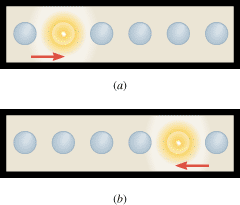Over the entrance to a restaurant is mounted a strip of equally spaced light bulbs, as Figure 10.13a illustrates. Starting at the left end, each bulb turns on in sequence for one-half second. Thus, a lighted bulb appears to move from left to right. Once the apparent motion of a lighted bulb reaches the right side of the sign, the motion reverses. The lighted bulb then appears to move to the left, as part b of the drawing indicates. Thus, the lighted bulb appears to oscillate back and forth. Is the apparent motion simple harmonic motion?
 |
|
Reasoning and Solution Since the bulbs are equally spaced and each bulb remains lit for the same amount of time, the apparent motion of a lighted bulb across the sign occurs at a constant speed. If the motion were simple harmonic motion, however, it would not have a constant speed (see Equation 10.7), because it would have zero speed at each end of the sign and increase to a maximum speed at the center of the sign. Therefore, although the apparent motion of a lighted bulb is oscillatory, it is not simple harmonic motion.